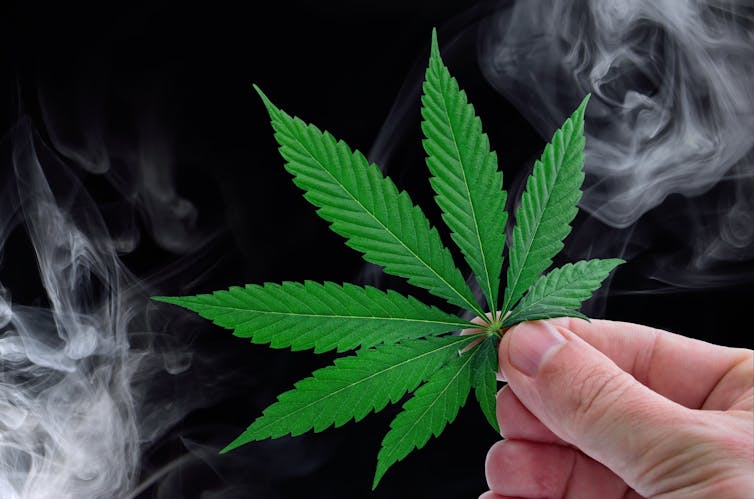
Cannabis is one of the most commonly used drugs in the world. Yet there’s still much we don’t know about it and what effects it has on the brain – including why cannabis triggers psychosis in some people who use the drug. But our recent study has just brought us closer to understanding the biological impact of high-potency cannabis use.
Published in the journal Molecular Psychiatry, our study demonstrates that high-potency cannabis leaves a distinct mark on DNA. We also found that these DNA changes were different in people experiencing their first episode of psychosis compared to users who’d never experienced psychosis. This suggests looking at how cannabis use modifies DNA could help identify those most at risk of developing psychosis.
The amount of THC (Delta-9_tetrahydrocannabinol), the main ingredient in cannabis that makes people feel “high”, has been steadily increasing since the 1990s in the UK and US. In Colorado, where the drug is legal, it’s possible to buy cannabis with 90% THC. While THC is one of over 144 other chemicals found in the cannabis plant, it’s the primary compound used to estimate the potency of cannabis.
Many studies have shown that the greater the THC concentration, the stronger the effects on the user. For example, research has found that people who use high-potency cannabis (with THC of 10% or more) daily are five times more likely to develop a psychotic disorder compared to people who have never used cannabis.
Psychotic disorders associated with daily use of high-potency cannabis often manifest through a range of symptoms. These can include auditory hallucinations (hearing voices that others cannot hear), delusions of persecution (feeling the target of a conspiracy without evidence) and paranoia (perceiving the environment as hostile and interpreting interactions suspiciously). These are all very distressing and disabling experiences.
Read more: Cannabis: how it affects our cognition and psychology – new research
Our study aimed the explore the mark that current cannabis use leaves on the DNA. We also wanted to understand if this mark is specific to high-potency cannabis use – and if this might help to identify those users at greater risk of experiencing psychosis.
To do this, we examined the effects of cannabis use on an molecular process called DNA methylation. DNA methylation is a chemical process that regulates gene activity by turning genes on or off and controlling how genes are expressed without changing the structure of the DNA itself. DNA methylation is just one of the many mechanisms that regulate gene activity and are part of an important biological process known as epigenetics. Epigenetics underpin the interplay between our environment, the lifestyle choices we make (such as using cannabis or exercising) and our physical and mental health.
While previous studies have investigated the impact of lifetime cannabis use on DNA methylation, they haven’t explored what effect regular use of different cannabis potencies has on this process. Nor have they explored how this affects with people who have psychosis.
Our study combined data from two large first case-control studies: the Genetic and Psychosis study, which was conducted in south London, and the EU-GEI study, which included participants from England, France, the Netherlands, Italy, Spain and Brazil. Both of these studies collected data on people experiencing their first episode of psychosis and participants who had no health problems and represented the local population.

In total, we looked at 239 people who were experiencing their first episode of psychosis and 443 healthy volunteers. Around 65% of participants were male. Participants ranged in age 16-72. All participants provided information on their cannabis use, as well as DNA samples from their blood.
Around 38% of participants were using cannabis more than once a week. Of those who had used cannabis, the majority had been using high-potency cannabis more than once a week – and had started when they were around 16 years old.
Analyses of DNA methylation were then performed across multiple parts of the whole genome. The analysis took into account the potential impact of several biological and environmental confounders that may have affected the results – such as age, gender, ethnicity, tobacco smoking and the cellular makeup of each blood sample.
DNA signature
Our findings revealed that using high-potency cannabis alters DNA methylation – particularly in genes related to energy and immune system functions. This was true for participants who had used high-potency cannabis. However, people who had experienced psychosis had a different signature of alteration in their DNA.
These epigenetic changes show how external factors (like drug use) can alter how genes work. Very importantly, these changes were not explained by tobacco – which is usually mixed into joints by many cannabis users, and is known to alter DNA methylation.
This finding also highlights epigenetic changes as a potential link between high-potency cannabis and psychosis. DNA methylation, which bridges the gap between genetics and environmental factors, is a key mechanism that allows external influences (such as substance use) to impact gene activity. By studying epigenetic changes, researchers may be able to develop a greater understanding on how cannabis use – particularly high-potency types – can influence specific biological pathways. This may in turn help us understand why some cannabis users are at increased risk of psychosis.
We hope that our findings will help scientists to better understand how cannabis use can affect the body’s biology. Future research should now investigate whether the DNA methylation patterns associated with cannabis use can serve as biomarkers to identify users at higher risk of developing psychosis. This could lead to more targeted prevention strategies and inform safer cannabis use practices.
Emma Dempster receives funding from MRC, NIHR, ARUK.
Marta Di Forti does not work for, consult, own shares in or receive funding from any company or organisation that would benefit from this article, and has disclosed no relevant affiliations beyond their academic appointment.
This article was originally published on The Conversation. Read the original article.







